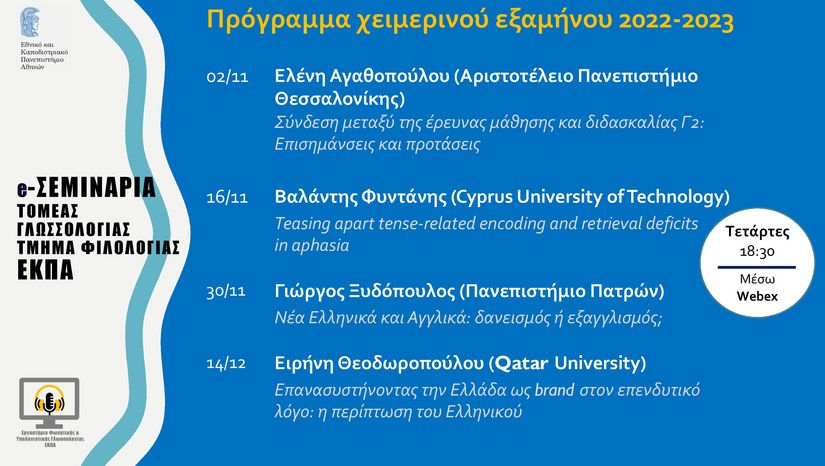ΕΚΔΗΛΩΣΕΙΣ
E-ΣΕΜΙΝΑΡΙΑ ΤΟΜΕΑ ΓΛΩΣΣΟΛΟΓΙΑΣ ΕΚΠΑ - ΒΑΛΑΝΤΗΣ ΦΥΝΔΑΝΗΣ (CYPRUS UNIVERSITY OF TECHNOLOGY)

Ο Τομέας Γλωσσολογίας σας προσκαλεί στην ομιλία του Βαλάντη Φυνδάνη (Cyprus University of Technology) με τίτλο "Teasing apart tense-related encoding and retrieval deficits in aphasia". Η ομιλία θα πραγματοποιηθεί την Τετάρτη 16 Νοεμβρίου 2022 στις 18.30, στον παρακάτω σύνδεσμο:
https://uoa.webex.com/uoa/j.php?MTID=m08b5d84de1419f7f88149b388d5ea9c4
Password: SuEmQeYc938
Η ομιλία πραγματοποιείται στα πλαίσια των e-σεμιναρίων που διοργανώνονται από τον Τομέα Γλωσσολογίας με τη συνδρομή του Εργαστηρίου Φωνητικής και Υπολογιστικής Γλωσσολογίας. Το πρόγραμμα όλων των ομιλιών του χειμερινού εξαμήνου βρίσκεται στον σύνδεσμο http://www.phil.uoa.gr/tomeis/tomeas-glwssologias/seminaria.html
Abstract
Persons with stroke-induced aphasia (PWAs) are often impaired in the production of time reference (TR). Moreover, they often exhibit dissociations between reference to the past and reference to the non-past (e.g., Bastiaanse et al., 2011; Fyndanis et al., 2018; Nerantzini et al., 2020). It is not clear, however, whether PWAs’ impaired TR production is due to tense-related encoding (TRE) deficits or tense-related retrieval (TRR) deficits. This study aims at disentangling TRE deficits from TRR deficits in aphasia. To this end, we designed two sentence completion tasks tapping TR (past and future) production. Task 1 was a transformational sentence completion task tapping TRE and TRR processes to a similar extent. Task 2 was a non-transformational sentence completion task predominantly tapping TRR processes. These tasks were administered to seven Greek-speaking PWAs, eight Russian-speaking PWAs, and two groups of age- and education-matched healthy controls. The results suggest that some PWAs had selective TRE deficits and others had selective TRR deficits. This experimental set-up, therefore, allowed us to identify the locus of TR impairment for each PWA. If you want to find out what the specific features of this design are and how it works, please join us and attend my talk!